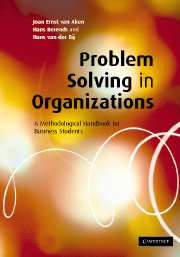Book contents
- Frontmatter
- Contents
- List of figures
- List of boxes
- Preface
- Part I Fundamentals
- Part II The problem-solving project
- 5 Intake and orientation
- 6 Theory-based diagnosis of business problems
- 7 Solution design
- 8 Change plan design and the actual change process
- 9 Evaluation, reflection and termination
- Part III On methods
- Part IV Conclusion
- References
- Index
6 - Theory-based diagnosis of business problems
from Part II - The problem-solving project
Published online by Cambridge University Press: 04 December 2009
- Frontmatter
- Contents
- List of figures
- List of boxes
- Preface
- Part I Fundamentals
- Part II The problem-solving project
- 5 Intake and orientation
- 6 Theory-based diagnosis of business problems
- 7 Solution design
- 8 Change plan design and the actual change process
- 9 Evaluation, reflection and termination
- Part III On methods
- Part IV Conclusion
- References
- Index
Summary
Introduction
This chapter concerns the second step of the regulative cycle: the analysis and diagnosis step. Our starting point in this chapter is that the first step, the problem-definition step, has been finished. Thus, in one way or another the problem has been defined, some of its potential causes and consequences identified, the assignment and the problem-solving approach determined.
The purposes of the diagnosis are to validate the business problem, to explore and validate the causes and consequences of the problem, and to develop preliminary ideas about alternative directions to solve the problem. At the end of the diagnostic step students must be convinced and able to convince others of the validity of the problem, its causes and its consequences. During the previous step of the regulative cycle, students are relatively passive. In this diagnostic step the students should be much more active: they must actively develop and execute strategies to explore and check the ideas of the organization members that came up during the definition of the problem.
Students who have little practical experience in business problem-solving (BPS) need more guidelines than more experienced consultants. However, compared with the previous step of problem definition, considerably more activities are situation-specific, which makes it more difficult to provide general guidelines. In our experience, the diagnostic step causes a lot of problems for students.
Information
- Type
- Chapter
- Information
- Problem Solving in OrganizationsA Methodological Handbook for Business Students, pp. 63 - 82Publisher: Cambridge University PressPrint publication year: 2007
